1994 JEEP CHEROKEE lock
[x] Cancel search: lockPage 1386 of 1784
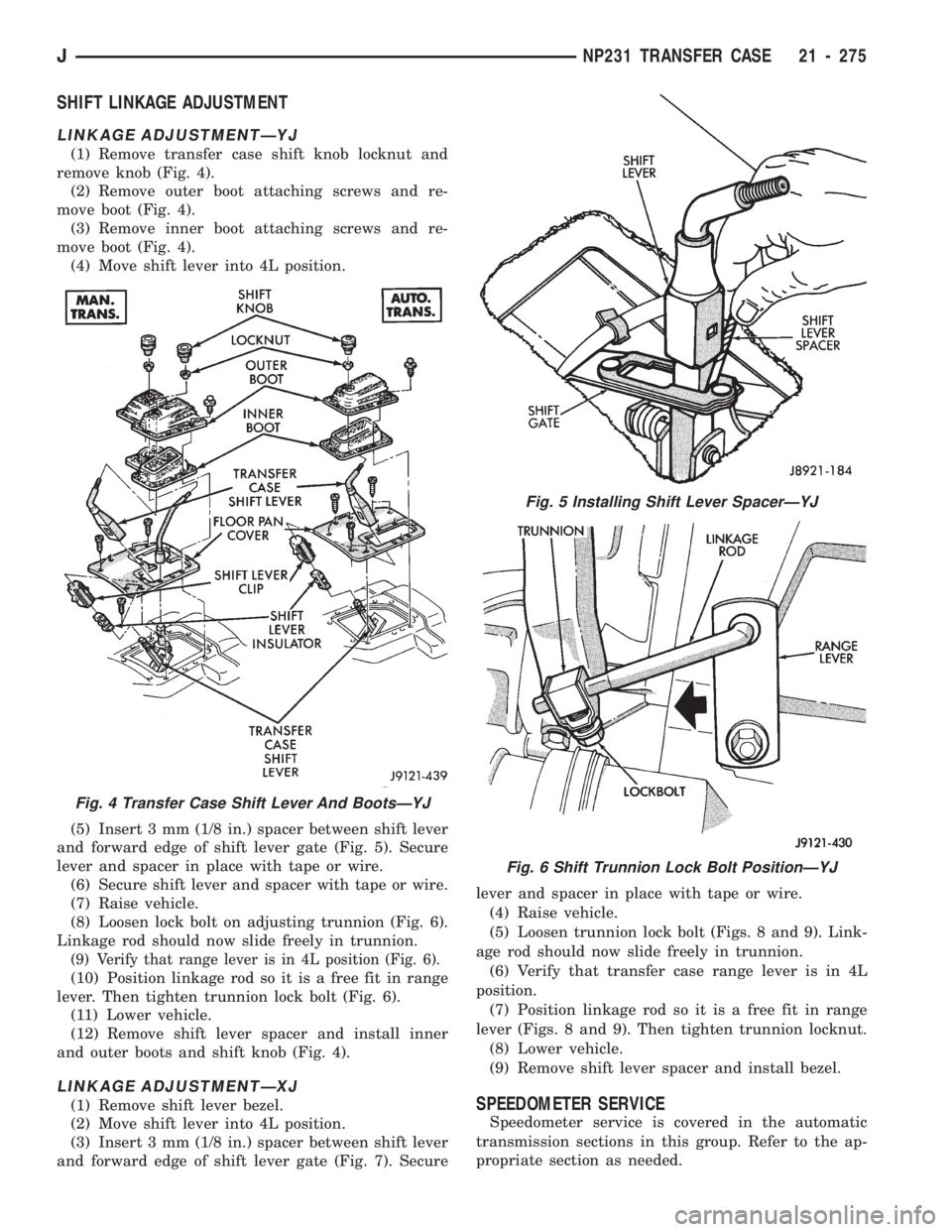
SHIFT LINKAGE ADJUSTMENT
LINKAGE ADJUSTMENTÐYJ
(1) Remove transfer case shift knob locknut and
remove knob (Fig. 4).
(2) Remove outer boot attaching screws and re-
move boot (Fig. 4).
(3) Remove inner boot attaching screws and re-
move boot (Fig. 4).
(4) Move shift lever into 4L position.
(5) Insert 3 mm (1/8 in.) spacer between shift lever
and forward edge of shift lever gate (Fig. 5). Secure
lever and spacer in place with tape or wire.
(6) Secure shift lever and spacer with tape or wire.
(7) Raise vehicle.
(8) Loosen lock bolt on adjusting trunnion (Fig. 6).
Linkage rod should now slide freely in trunnion.
(9) Verify that range lever is in 4L position (Fig. 6).
(10) Position linkage rod so it is a free fit in range
lever. Then tighten trunnion lock bolt (Fig. 6).
(11) Lower vehicle.
(12) Remove shift lever spacer and install inner
and outer boots and shift knob (Fig. 4).
LINKAGE ADJUSTMENTÐXJ
(1) Remove shift lever bezel.
(2) Move shift lever into 4L position.
(3) Insert 3 mm (1/8 in.) spacer between shift lever
and forward edge of shift lever gate (Fig. 7). Securelever and spacer in place with tape or wire.
(4) Raise vehicle.
(5) Loosen trunnion lock bolt (Figs. 8 and 9). Link-
age rod should now slide freely in trunnion.
(6) Verify that transfer case range lever is in 4L
position.
(7) Position linkage rod so it is a free fit in range
lever (Figs. 8 and 9). Then tighten trunnion locknut.
(8) Lower vehicle.
(9) Remove shift lever spacer and install bezel.SPEEDOMETER SERVICE
Speedometer service is covered in the automatic
transmission sections in this group. Refer to the ap-
propriate section as needed.
Fig. 4 Transfer Case Shift Lever And BootsÐYJ
Fig. 5 Installing Shift Lever SpacerÐYJ
Fig. 6 Shift Trunnion Lock Bolt PositionÐYJ
JNP231 TRANSFER CASE 21 - 275
Page 1388 of 1784
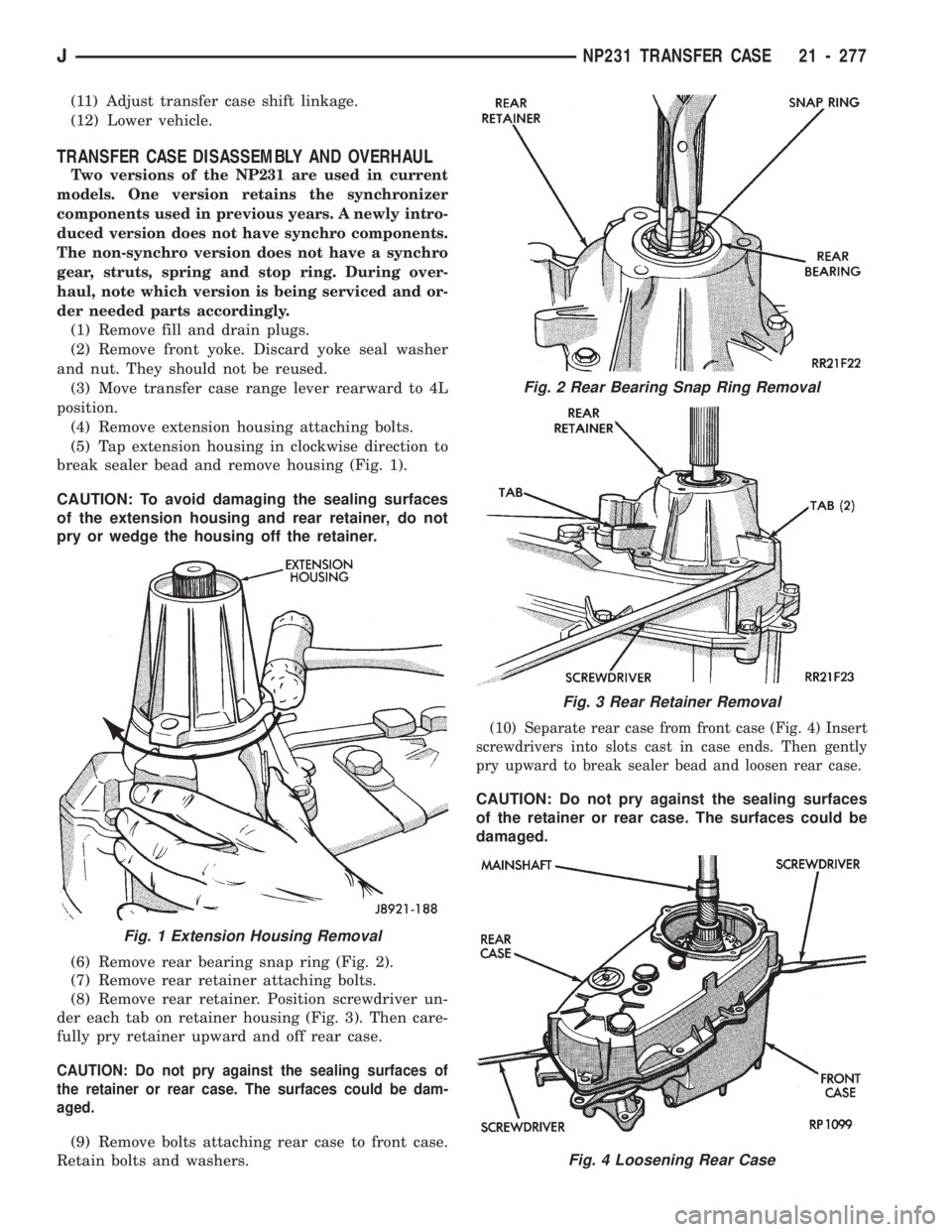
(11) Adjust transfer case shift linkage.
(12) Lower vehicle.
TRANSFER CASE DISASSEMBLY AND OVERHAUL
Two versions of the NP231 are used in current
models. One version retains the synchronizer
components used in previous years. A newly intro-
duced version does not have synchro components.
The non-synchro version does not have a synchro
gear, struts, spring and stop ring. During over-
haul, note which version is being serviced and or-
der needed parts accordingly.
(1) Remove fill and drain plugs.
(2) Remove front yoke. Discard yoke seal washer
and nut. They should not be reused.
(3) Move transfer case range lever rearward to 4L
position.
(4) Remove extension housing attaching bolts.
(5) Tap extension housing in clockwise direction to
break sealer bead and remove housing (Fig. 1).
CAUTION: To avoid damaging the sealing surfaces
of the extension housing and rear retainer, do not
pry or wedge the housing off the retainer.
(6) Remove rear bearing snap ring (Fig. 2).
(7) Remove rear retainer attaching bolts.
(8) Remove rear retainer. Position screwdriver un-
der each tab on retainer housing (Fig. 3). Then care-
fully pry retainer upward and off rear case.
CAUTION: Do not pry against the sealing surfaces of
the retainer or rear case. The surfaces could be dam-
aged.
(9) Remove bolts attaching rear case to front case.
Retain bolts and washers.
(10) Separate rear case from front case (Fig. 4) Insert
screwdrivers into slots cast in case ends. Then gently
pry upward to break sealer bead and loosen rear case.
CAUTION: Do not pry against the sealing surfaces
of the retainer or rear case. The surfaces could be
damaged.
Fig. 1 Extension Housing Removal
Fig. 2 Rear Bearing Snap Ring Removal
Fig. 3 Rear Retainer Removal
Fig. 4 Loosening Rear Case
JNP231 TRANSFER CASE 21 - 277
Page 1393 of 1784
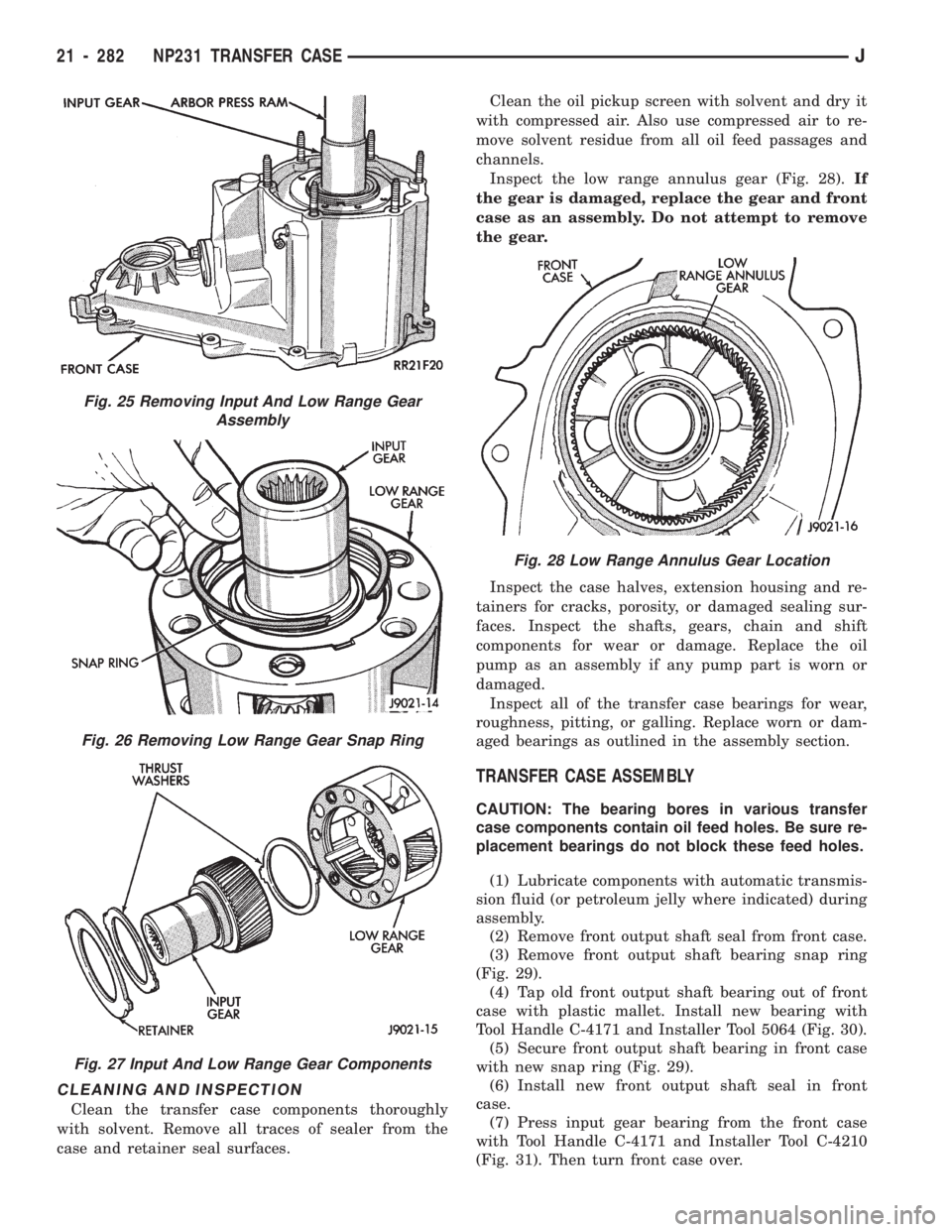
CLEANING AND INSPECTION
Clean the transfer case components thoroughly
with solvent. Remove all traces of sealer from the
case and retainer seal surfaces.Clean the oil pickup screen with solvent and dry it
with compressed air. Also use compressed air to re-
move solvent residue from all oil feed passages and
channels.
Inspect the low range annulus gear (Fig. 28).If
the gear is damaged, replace the gear and front
case as an assembly. Do not attempt to remove
the gear.
Inspect the case halves, extension housing and re-
tainers for cracks, porosity, or damaged sealing sur-
faces. Inspect the shafts, gears, chain and shift
components for wear or damage. Replace the oil
pump as an assembly if any pump part is worn or
damaged.
Inspect all of the transfer case bearings for wear,
roughness, pitting, or galling. Replace worn or dam-
aged bearings as outlined in the assembly section.
TRANSFER CASE ASSEMBLY
CAUTION: The bearing bores in various transfer
case components contain oil feed holes. Be sure re-
placement bearings do not block these feed holes.
(1) Lubricate components with automatic transmis-
sion fluid (or petroleum jelly where indicated) during
assembly.
(2) Remove front output shaft seal from front case.
(3) Remove front output shaft bearing snap ring
(Fig. 29).
(4) Tap old front output shaft bearing out of front
case with plastic mallet. Install new bearing with
Tool Handle C-4171 and Installer Tool 5064 (Fig. 30).
(5) Secure front output shaft bearing in front case
with new snap ring (Fig. 29).
(6) Install new front output shaft seal in front
case.
(7) Press input gear bearing from the front case
with Tool Handle C-4171 and Installer Tool C-4210
(Fig. 31). Then turn front case over.
Fig. 25 Removing Input And Low Range Gear
Assembly
Fig. 26 Removing Low Range Gear Snap Ring
Fig. 27 Input And Low Range Gear Components
Fig. 28 Low Range Annulus Gear Location
21 - 282 NP231 TRANSFER CASEJ
Page 1396 of 1784
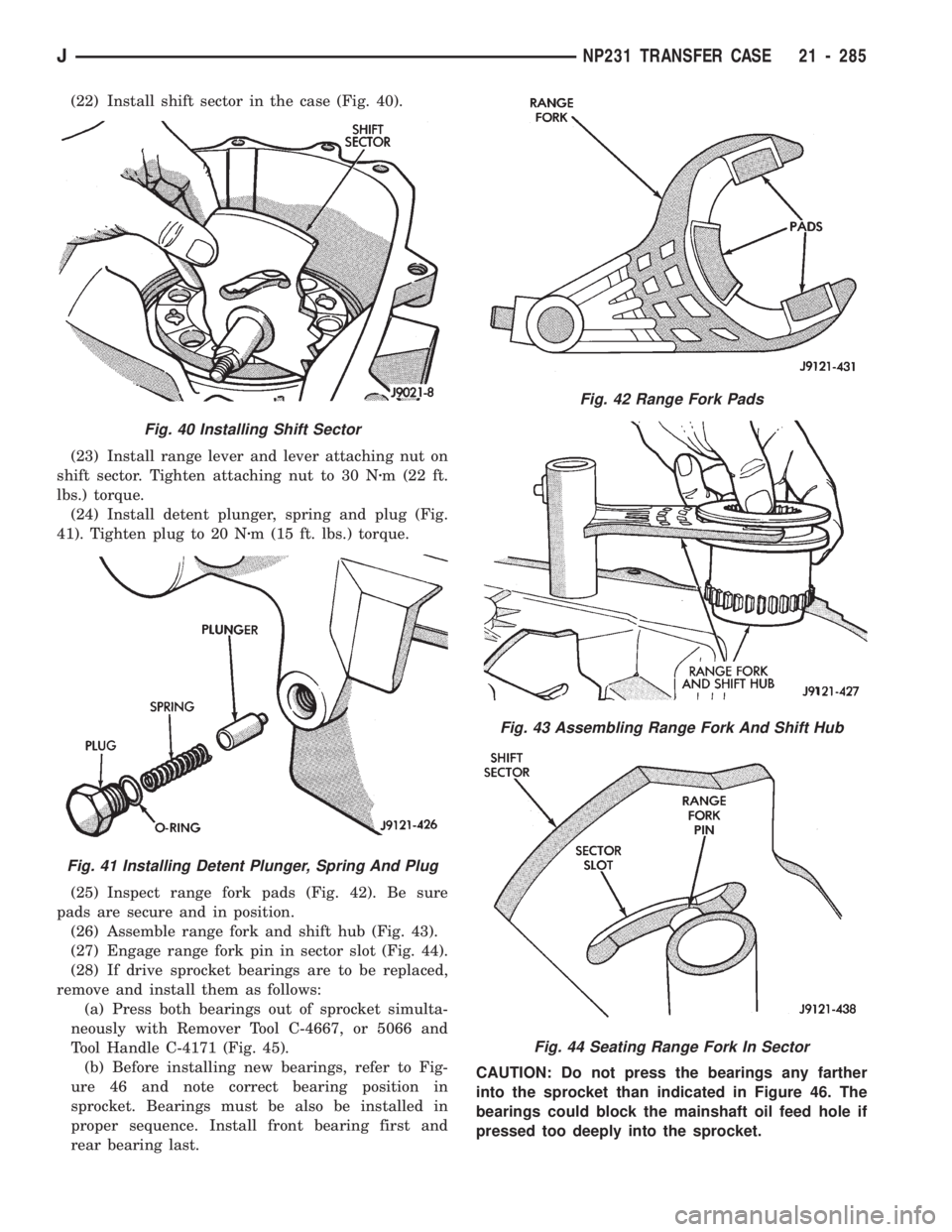
(22) Install shift sector in the case (Fig. 40).
(23) Install range lever and lever attaching nut on
shift sector. Tighten attaching nut to 30 Nzm (22 ft.
lbs.) torque.
(24) Install detent plunger, spring and plug (Fig.
41). Tighten plug to 20 Nzm (15 ft. lbs.) torque.
(25) Inspect range fork pads (Fig. 42). Be sure
pads are secure and in position.
(26) Assemble range fork and shift hub (Fig. 43).
(27) Engage range fork pin in sector slot (Fig. 44).
(28) If drive sprocket bearings are to be replaced,
remove and install them as follows:
(a) Press both bearings out of sprocket simulta-
neously with Remover Tool C-4667, or 5066 and
Tool Handle C-4171 (Fig. 45).
(b) Before installing new bearings, refer to Fig-
ure 46 and note correct bearing position in
sprocket. Bearings must be also be installed in
proper sequence. Install front bearing first and
rear bearing last.CAUTION: Do not press the bearings any farther
into the sprocket than indicated in Figure 46. The
bearings could block the mainshaft oil feed hole if
pressed too deeply into the sprocket.
Fig. 42 Range Fork Pads
Fig. 43 Assembling Range Fork And Shift Hub
Fig. 44 Seating Range Fork In Sector
Fig. 40 Installing Shift Sector
Fig. 41 Installing Detent Plunger, Spring And Plug
JNP231 TRANSFER CASE 21 - 285
Page 1404 of 1784
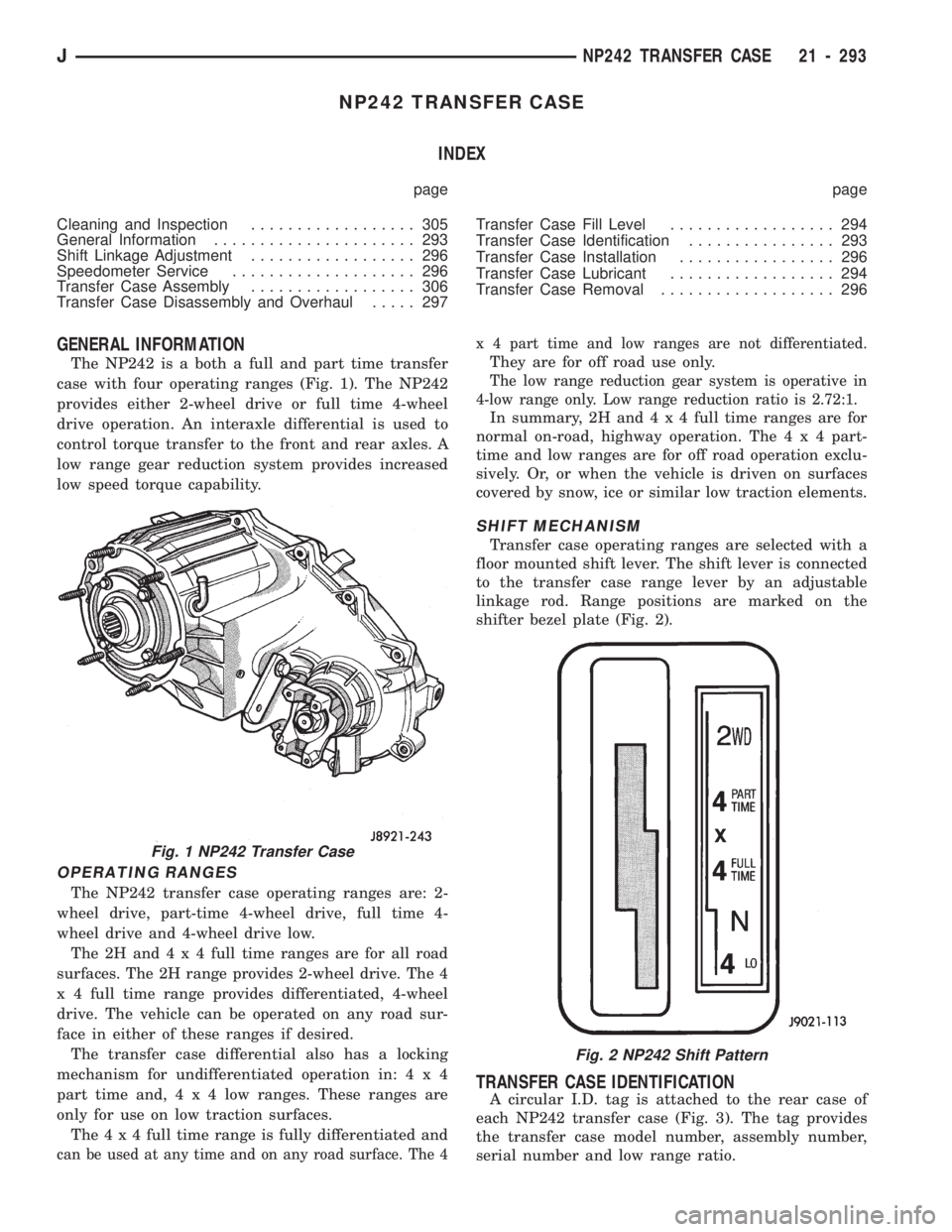
NP242 TRANSFER CASE
INDEX
page page
Cleaning and Inspection.................. 305
General Information...................... 293
Shift Linkage Adjustment.................. 296
Speedometer Service.................... 296
Transfer Case Assembly.................. 306
Transfer Case Disassembly and Overhaul..... 297Transfer Case Fill Level.................. 294
Transfer Case Identification................ 293
Transfer Case Installation................. 296
Transfer Case Lubricant.................. 294
Transfer Case Removal................... 296
GENERAL INFORMATION
The NP242 is a both a full and part time transfer
case with four operating ranges (Fig. 1). The NP242
provides either 2-wheel drive or full time 4-wheel
drive operation. An interaxle differential is used to
control torque transfer to the front and rear axles. A
low range gear reduction system provides increased
low speed torque capability.
OPERATING RANGES
The NP242 transfer case operating ranges are: 2-
wheel drive, part-time 4-wheel drive, full time 4-
wheel drive and 4-wheel drive low.
The2Hand4x4full time ranges are for all road
surfaces. The 2H range provides 2-wheel drive. The 4
x 4 full time range provides differentiated, 4-wheel
drive. The vehicle can be operated on any road sur-
face in either of these ranges if desired.
The transfer case differential also has a locking
mechanism for undifferentiated operation in:4x4
part time and,4x4lowranges. These ranges are
only for use on low traction surfaces.
The4x4full time range is fully differentiated and
can be used at any time and on any road surface. The 4x 4 part time and low ranges are not differentiated.
They are for off road use only.
The low range reduction gear system is operative in
4-low range only. Low range reduction ratio is 2.72:1.
In summary, 2H and4x4full time ranges are for
normal on-road, highway operation. The4x4part-
time and low ranges are for off road operation exclu-
sively. Or, or when the vehicle is driven on surfaces
covered by snow, ice or similar low traction elements.
SHIFT MECHANISM
Transfer case operating ranges are selected with a
floor mounted shift lever. The shift lever is connected
to the transfer case range lever by an adjustable
linkage rod. Range positions are marked on the
shifter bezel plate (Fig. 2).
TRANSFER CASE IDENTIFICATION
A circular I.D. tag is attached to the rear case of
each NP242 transfer case (Fig. 3). The tag provides
the transfer case model number, assembly number,
serial number and low range ratio.
Fig. 1 NP242 Transfer Case
Fig. 2 NP242 Shift Pattern
JNP242 TRANSFER CASE 21 - 293
Page 1407 of 1784
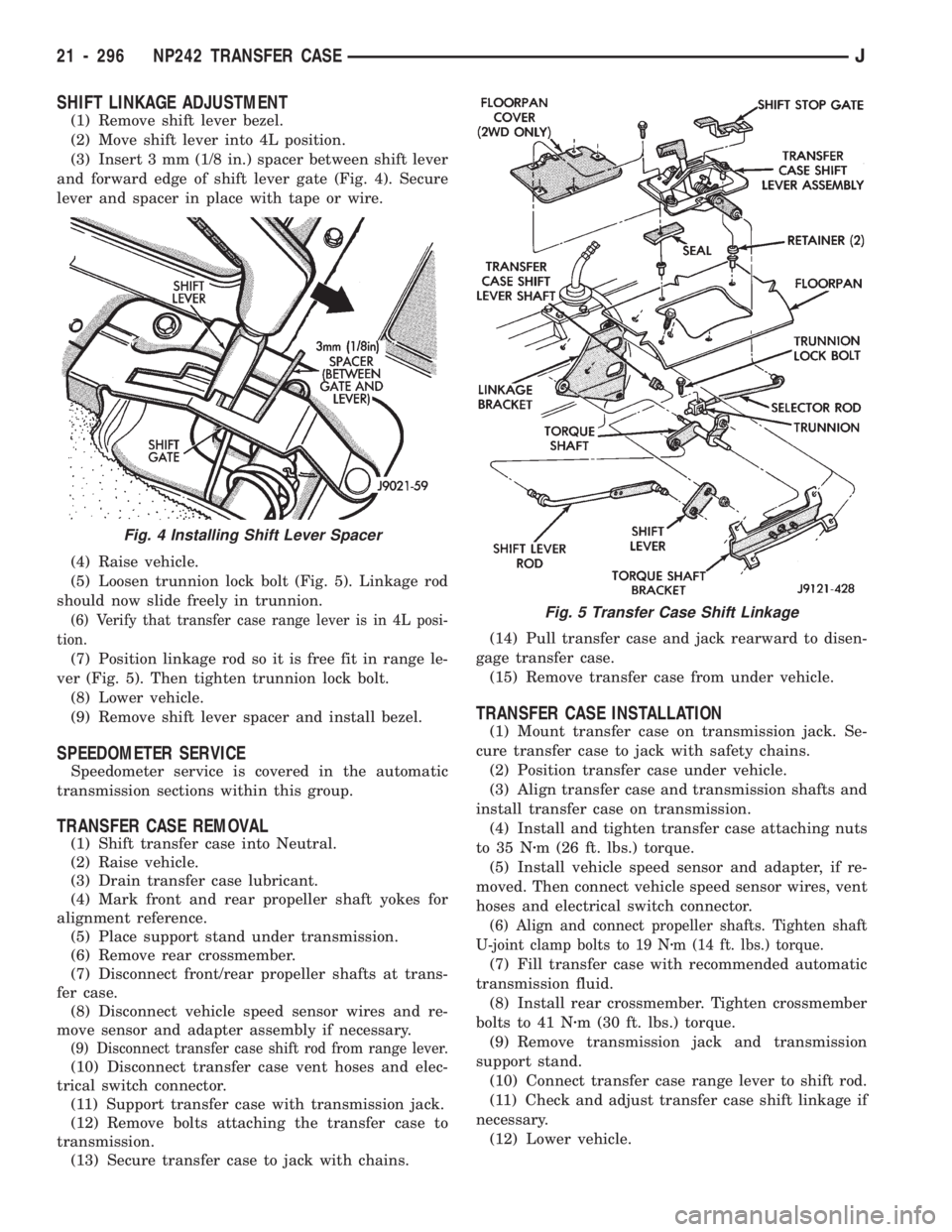
SHIFT LINKAGE ADJUSTMENT
(1) Remove shift lever bezel.
(2) Move shift lever into 4L position.
(3) Insert 3 mm (1/8 in.) spacer between shift lever
and forward edge of shift lever gate (Fig. 4). Secure
lever and spacer in place with tape or wire.
(4) Raise vehicle.
(5) Loosen trunnion lock bolt (Fig. 5). Linkage rod
should now slide freely in trunnion.
(6) Verify that transfer case range lever is in 4L posi-
tion.
(7) Position linkage rod so it is free fit in range le-
ver (Fig. 5). Then tighten trunnion lock bolt.
(8) Lower vehicle.
(9) Remove shift lever spacer and install bezel.
SPEEDOMETER SERVICE
Speedometer service is covered in the automatic
transmission sections within this group.
TRANSFER CASE REMOVAL
(1) Shift transfer case into Neutral.
(2) Raise vehicle.
(3) Drain transfer case lubricant.
(4) Mark front and rear propeller shaft yokes for
alignment reference.
(5) Place support stand under transmission.
(6) Remove rear crossmember.
(7) Disconnect front/rear propeller shafts at trans-
fer case.
(8) Disconnect vehicle speed sensor wires and re-
move sensor and adapter assembly if necessary.
(9) Disconnect transfer case shift rod from range lever.
(10) Disconnect transfer case vent hoses and elec-
trical switch connector.
(11) Support transfer case with transmission jack.
(12) Remove bolts attaching the transfer case to
transmission.
(13) Secure transfer case to jack with chains.(14) Pull transfer case and jack rearward to disen-
gage transfer case.
(15) Remove transfer case from under vehicle.
TRANSFER CASE INSTALLATION
(1) Mount transfer case on transmission jack. Se-
cure transfer case to jack with safety chains.
(2) Position transfer case under vehicle.
(3) Align transfer case and transmission shafts and
install transfer case on transmission.
(4) Install and tighten transfer case attaching nuts
to 35 Nzm (26 ft. lbs.) torque.
(5) Install vehicle speed sensor and adapter, if re-
moved. Then connect vehicle speed sensor wires, vent
hoses and electrical switch connector.
(6) Align and connect propeller shafts. Tighten shaft
U-joint clamp bolts to 19 Nzm (14 ft. lbs.) torque.
(7) Fill transfer case with recommended automatic
transmission fluid.
(8) Install rear crossmember. Tighten crossmember
bolts to 41 Nzm (30 ft. lbs.) torque.
(9) Remove transmission jack and transmission
support stand.
(10) Connect transfer case range lever to shift rod.
(11) Check and adjust transfer case shift linkage if
necessary.
(12) Lower vehicle.
Fig. 4 Installing Shift Lever Spacer
Fig. 5 Transfer Case Shift Linkage
21 - 296 NP242 TRANSFER CASEJ
Page 1408 of 1784
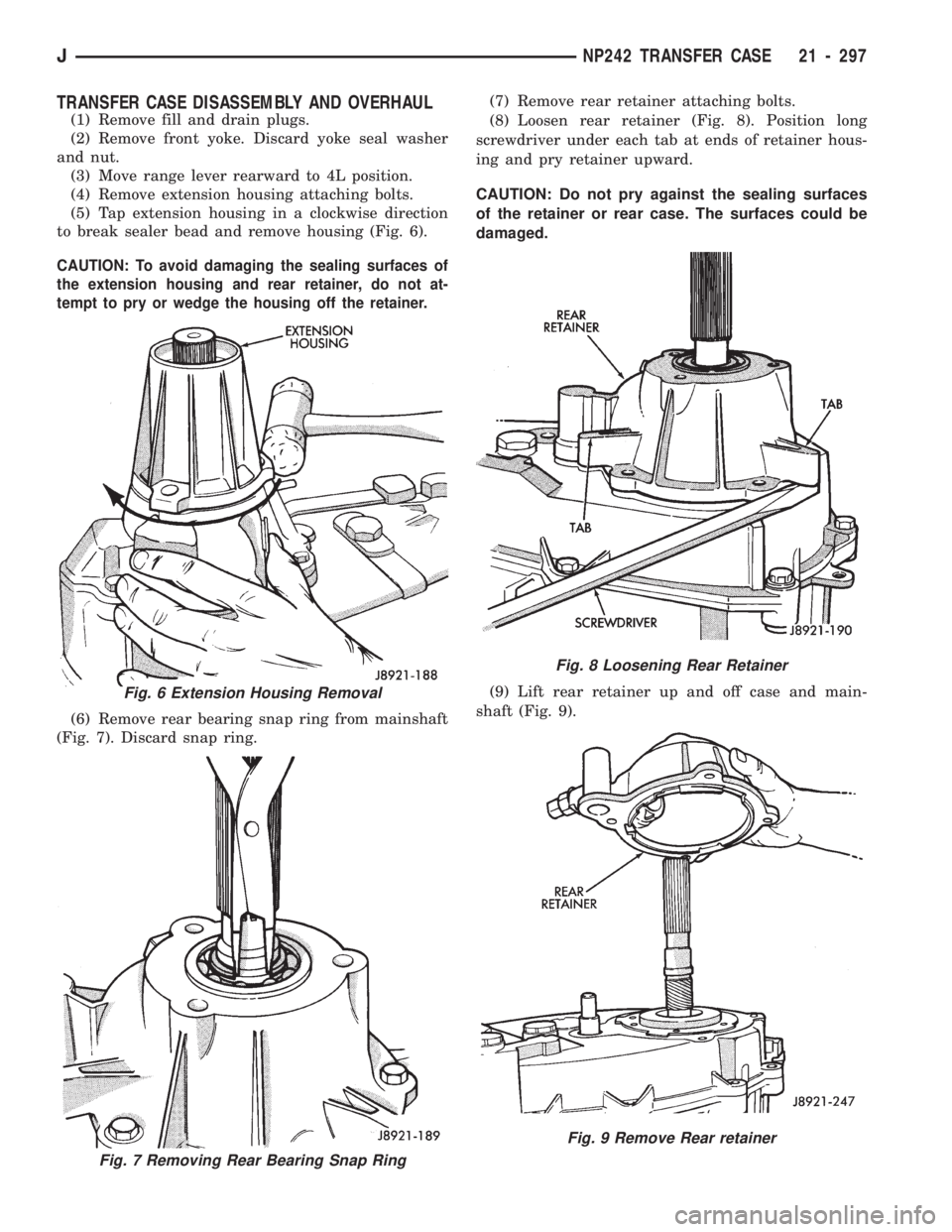
TRANSFER CASE DISASSEMBLY AND OVERHAUL
(1) Remove fill and drain plugs.
(2) Remove front yoke. Discard yoke seal washer
and nut.
(3) Move range lever rearward to 4L position.
(4) Remove extension housing attaching bolts.
(5) Tap extension housing in a clockwise direction
to break sealer bead and remove housing (Fig. 6).
CAUTION: To avoid damaging the sealing surfaces of
the extension housing and rear retainer, do not at-
tempt to pry or wedge the housing off the retainer.
(6) Remove rear bearing snap ring from mainshaft
(Fig. 7). Discard snap ring.(7) Remove rear retainer attaching bolts.
(8) Loosen rear retainer (Fig. 8). Position long
screwdriver under each tab at ends of retainer hous-
ing and pry retainer upward.
CAUTION: Do not pry against the sealing surfaces
of the retainer or rear case. The surfaces could be
damaged.
(9) Lift rear retainer up and off case and main-
shaft (Fig. 9).
Fig. 7 Removing Rear Bearing Snap Ring
Fig. 6 Extension Housing Removal
Fig. 8 Loosening Rear Retainer
Fig. 9 Remove Rear retainer
JNP242 TRANSFER CASE 21 - 297
Page 1411 of 1784
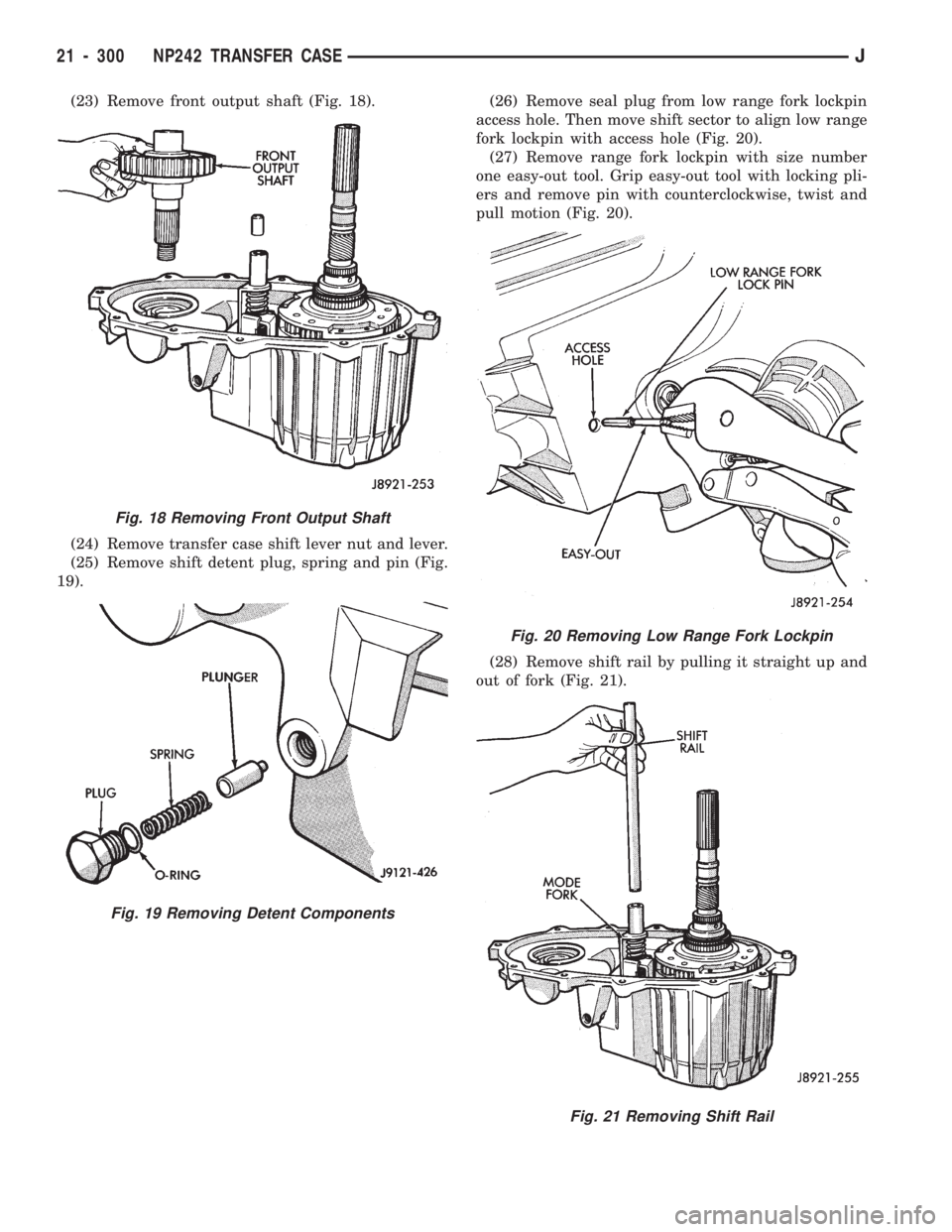
(23) Remove front output shaft (Fig. 18).
(24) Remove transfer case shift lever nut and lever.
(25) Remove shift detent plug, spring and pin (Fig.
19).(26) Remove seal plug from low range fork lockpin
access hole. Then move shift sector to align low range
fork lockpin with access hole (Fig. 20).
(27) Remove range fork lockpin with size number
one easy-out tool. Grip easy-out tool with locking pli-
ers and remove pin with counterclockwise, twist and
pull motion (Fig. 20).
(28) Remove shift rail by pulling it straight up and
out of fork (Fig. 21).
Fig. 18 Removing Front Output Shaft
Fig. 19 Removing Detent Components
Fig. 20 Removing Low Range Fork Lockpin
Fig. 21 Removing Shift Rail
21 - 300 NP242 TRANSFER CASEJ